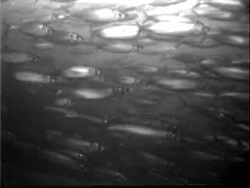Orcas
Cooperative feeding is a strategy common to social carnivores like orcas. [9] Some of the strategies orcas employ include producing large waves to knock seals off ice floes, or even beaching themselves to catch sea lions. [10] The strategies orcas develop depend on their typical prey type and the most efficient method to capture them considering environmental conditions. Norwegian orcas have developed carousel feeding because it is an effective method to capture spring-spawning herring. [1]
Carousel feeding teaches young individuals important hunting skills. [3] This gives the orcas an evolutionary advantage that helps them ensure the survival of their young. In a K-selected species like orcas parental investment in offspring is very important. This includes teaching the offspring skills to improve their chances of survival. Young orcas learn prey-specific hunting techniques by both imitation of conspecifics and social learning. The amount of parental involvement in learning a hunting behaviour depends on how risky it is. Since carousel feeding is not very risky for young orcas they can participate as soon as they are able. For hunting behaviours that involve sharks or beaching themselves the young orcas are slowly introduced. [11]
The abundance of orcas in a particular area is related to the distribution of spring-spawn herring. Norwegian orcas are most commonly seen in the waters near northern Norway in the fall. This coincides with the wintering of spring-spawning herring. Cod and saithe are also common in the area but studies examining the stomach contents of Norwegian killer whales show the primary biomass consumed is from herring. [1] This is likely due to herring being the most abundant at this time. In the summer many Norwegian orca pods move to the coast of the Lofoten and Vesterålen islands where adolescent herring, mackerel and saithe are more abundant. In addition, whales return to the same regions each season where herring are abundant. Since herring are the Norwegian orca's main food source it is clearly adaptive to have produced a cooperative feeding method specific to the predation of this species. [12]
Herring
Herring are an important food source for Norwegian orcas; therefore, their distributions influence each other. Herring influence the distribution of orcas and orcas can have a large impact on the population of herring. The herring population is not completely depleted by orcas because they never eat the whole herring ball during the feeding phase of carousel feeding. [2] The herring that are not consumed are able to escape from the orcas. This means the orcas do not completely deplete their food source and potentially the strongest herring will survive the event. [1]
Herrings also have certain adaptive behaviours to protect themselves against predation. The schooling behaviour of herring is largely the reason that many can survive these predation events. Herring are known to form very dense schools when swimming in the more dangerous open ocean, and smaller, less dense schools when closer to the shore where there is less risk of predation. Their ability to change behaviour depending on the situation allows more herring to survive the attack. The selective pressure just one orca pod can put on herrings in the area can emphasize anti-predator behaviours over feeding or mating behaviours. [13] Another example of anti-predator behaviour is the release of gas bubbles from the herring. Orcas force the herring up from large depths, which causes the herring to release gas bubbles in an attempt to disorient predators visually and acoustically. [14]
Carousel feeding can provide food for other species as well as orcas. For example, during a feeding event when the herring have been pushed to the surface of the water, seabirds are often seen feeding on the herring from above. In addition, stunned herring that are left behind by the orcas can be consumed by other fish. [2]

